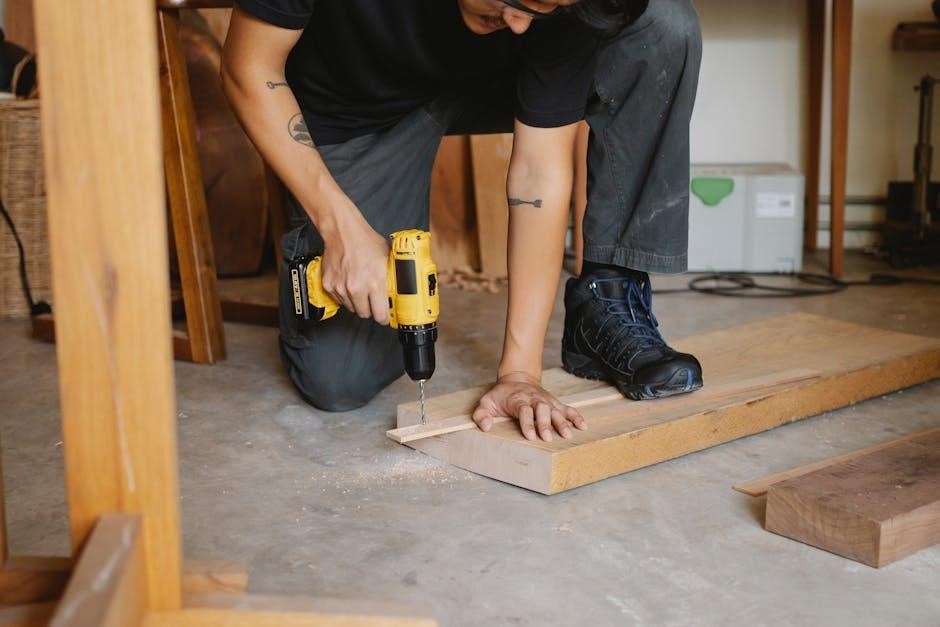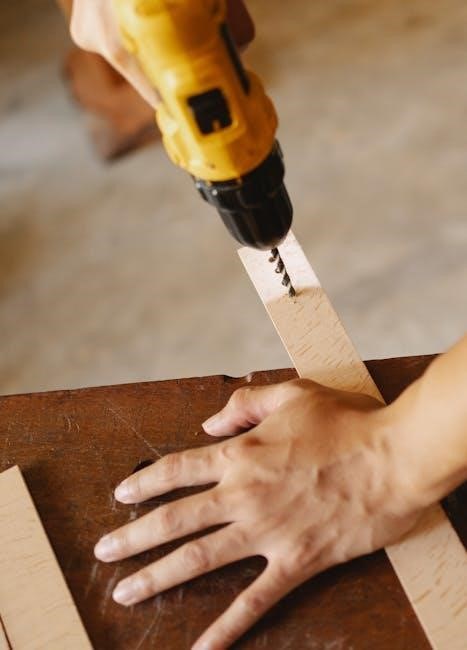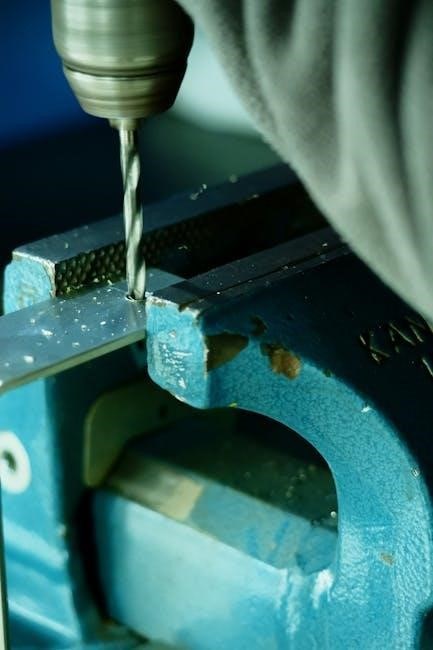
cap drill manual
The CAP Drill Manual provides standardized procedures for cadets to master drill techniques‚ fostering leadership‚ teamwork‚ and military bearing. It outlines the Demo-Perf method and essential protocols for training and ceremonies.
1.1 Overview of the CAP Drill Manual
The CAP Drill Manual is a comprehensive guide outlining standardized drill and ceremony procedures for Civil Air Patrol cadets and members. It covers stationary drill‚ marching‚ formations‚ commands‚ and cadence‚ ensuring uniformity and precision. The manual also addresses ceremonial protocols‚ color guard procedures‚ and proper conduct during events. Based on AFMAN 36-2203 but tailored for CAP‚ it provides specific guidance for cadets to develop leadership‚ teamwork‚ and military bearing. This resource is essential for training‚ testing‚ and mastering drill skills‚ serving as a foundation for personal and team growth within the CAP program.
1.2 History and Evolution of CAP Drill
CAP drill has evolved significantly since its inception‚ drawing from military traditions while adapting to the organization’s unique mission. Originally aligned with Air Force protocols‚ CAP developed its own manual‚ CAPP 60-33‚ to address specific needs. This shift provided cadets with tailored guidance‚ enhancing leadership development and teamwork. Over time‚ updates have incorporated feedback from members‚ ensuring relevance and effectiveness. The manual’s evolution reflects CAP’s commitment to fostering discipline and unity‚ maintaining its role as a vital tool for cadet training and ceremonies.
1.3 Purpose and Importance of Drill in CAP
Drill is a cornerstone of the Civil Air Patrol program‚ teaching cadets discipline‚ precision‚ and military bearing. It fosters leadership skills by enabling cadets to command formations and guide their peers. Drill also promotes teamwork‚ as members synchronize movements to function as a cohesive unit. The structured environment builds self-confidence and teaches the importance of following and issuing clear commands. By mastering drill‚ cadets develop the self-discipline and poise necessary for success in CAP and beyond. Drill ceremonies further enhance unity and pride among members‚ reinforcing CAP’s values and traditions.

Key Documents Related to CAP Drill
The primary documents guiding CAP drill include CAPP 60-33‚ AFMAN 36-2203‚ and other CAP publications‚ providing essential procedures‚ commands‚ and ceremonial protocols for members.
2.1 CAPP 60-33: Civil Air Patrol Drill and Ceremonies Manual
CAPP 60-33 is the official guide for CAP drill and ceremonies‚ offering detailed procedures for cadets and units. It includes commands‚ formations‚ and protocols‚ ensuring uniformity and precision in drills.
2.2 AFMAN 36-2203: Air Force Drill and Ceremonies Manual
AFMAN 36-2203 is the Air Force’s official manual for drill and ceremonies‚ adopted by CAP to align with military standards. It covers procedures‚ commands‚ and formations‚ ensuring cadets master disciplined movements and protocols.
2.3 Other Relevant CAP Publications
Beyond the primary manuals‚ CAP offers additional resources to enhance drill mastery. The Pocket Drill Guide provides cadets with a concise reference for quick review. Learn To Lead: Drill & Ceremonies Practical Tests (CAPP 60-34) outlines evaluation criteria and score sheets. Other publications‚ such as CAPP 60-20 (New Cadet Guide) and CAPP 60-31 (Cadet Staff Handbook)‚ include supplementary drill information. These materials ensure cadets have comprehensive tools to excel in drill training‚ covering everything from basic commands to advanced ceremonies. Together‚ they support the development of leadership‚ discipline‚ and precision in CAP cadets.

Benefits of Drill Training in CAP
Drill training fosters leadership‚ enhances teamwork‚ builds discipline‚ and nurtures self-confidence. It instills military bearing‚ promoting cohesion and precision among cadets‚ preparing them for future challenges.
3.1 Development of Leadership Skills
Drill training in CAP plays a pivotal role in fostering leadership skills among cadets. By mastering drill commands and executing precise movements‚ cadets develop decision-making abilities and learn to think critically. Leading formations requires clear communication and assertiveness‚ which are essential for effective leadership. Cadets also gain experience in motivating and guiding their peers‚ enhancing their ability to work collaboratively toward common goals. Drill instills discipline and responsibility‚ qualities that are fundamental for leaders. As cadets progress‚ they learn to delegate tasks and inspire teamwork‚ preparing them for future leadership roles both within CAP and beyond. These skills are invaluable for personal and professional growth.
3.2 Enhancement of Teamwork and Discipline
Drill training in CAP fosters teamwork by requiring cadets to work together as a unified group‚ ensuring synchronized movements and responses to commands. This shared responsibility builds camaraderie and trust among members. Discipline is cultivated through adherence to precise procedures‚ attention to detail‚ and maintaining proper posture and focus. Cadets learn to rely on each other‚ understanding that individual performance impacts the entire team. The structured environment of drill teaches accountability and the importance of following rules‚ which translates into greater self-control and respect for authority. These experiences strengthen both personal and collective discipline‚ creating a foundation for success in all areas of life.
3.3 Building Self-Confidence and Military Bearing
Drill training in CAP plays a pivotal role in fostering self-confidence and military bearing among cadets. By mastering precise movements and commands‚ cadets develop a sense of accomplishment and pride in their abilities. Standing at attention‚ executing commands with clarity‚ and maintaining proper posture instill discipline and self-discipline. As cadets progress‚ they gain confidence in leading others and communicating effectively‚ which translates into improved leadership skills. Military bearing‚ characterized by respect‚ professionalism‚ and composure‚ becomes second nature‚ shaping how cadets carry themselves both in and out of uniform. These qualities not only enhance personal growth but also prepare cadets for challenges beyond the drill floor.

CAP Drill Training Sequence
The CAP Drill Training Sequence begins with the Demo-Perf method‚ teaching formations‚ movements‚ and commands. Cadets progress from basic to advanced techniques‚ refining precision and leadership skills.
4.1 The Demo-Perf Method in Drill Training
The Demo-Perf method is a structured approach to teaching drill‚ emphasizing demonstration and practice. Instructors first demonstrate a maneuver‚ ensuring clarity and precision. Cadets then perform the maneuver‚ applying what they’ve observed. This hands-on method fosters understanding and mastery‚ allowing for immediate feedback and refinement. The Demo-Perf sequence ensures cadets grasp both the technical aspects of drill and the leadership skills required to execute commands confidently. This method is central to CAP’s training philosophy‚ promoting a culture of precision‚ discipline‚ and teamwork.
4.2 Formations and Movements
Formations and movements are fundamental to CAP drill training‚ ensuring unity and precision among cadets. Common formations include squad‚ flight‚ and element‚ each with specific alignment and spacing requirements. Movements such as forward march‚ halt‚ and about face are executed with crisp‚ synchronized actions. These exercises teach cadets to maintain proper intervals‚ dress lines‚ and timing. Precision in formations and movements fosters discipline‚ teamwork‚ and a sense of collective purpose. Mastery of these elements is essential for ceremonies‚ parades‚ and other official events‚ reflecting the professionalism and cohesion of CAP units. Regular practice reinforces these skills‚ preparing cadets for advanced drill sequences.
4.3 Progression from Basic to Advanced Drill
The CAP Drill Manual outlines a structured progression from basic to advanced drill‚ ensuring cadets build a strong foundation before advancing. Basic drill introduces fundamental commands like “attention” and “parade rest‚” focusing on proper posture and alignment. As cadets master these‚ they progress to more complex movements‚ such as marching‚ turns‚ and facing movements. Advanced drill incorporates ceremonial commands‚ intricate formations‚ and synchronized actions‚ preparing cadets for color guards and formal events. This progression enhances discipline‚ coordination‚ and leadership skills‚ culminating in a polished‚ professional performance. Regular practice and evaluation ensure a smooth transition between levels‚ fostering confidence and mastery of drill techniques.

Common Drill Commands in CAP
Common drill commands include “left face‚” “right face‚” “about face‚” “present arms‚” “eyes right‚” “eyes left‚” “at ease‚” and “fall in‚” essential for precise execution and unity.
5.1 Basic Commands and Responses
Basic commands are fundamental to CAP drill training‚ ensuring unity and precision. Commands like “Attention‚” “At Ease‚” “Left Face‚” “Right Face‚” and “About Face” are foundational. Responses such as “Yes‚ sir/ma’am‚” “No‚ sir/ma’am‚” and “Aye‚ airmen” demonstrate discipline. Cadets must execute commands instantly‚ reflecting split-second responses. Proper posture and alignment are critical during commands like “Present Arms” and “Eyes Right/Left.” Understanding these basics builds a strong foundation for advanced drill maneuvers. Mastery of commands and responses fosters teamwork‚ discipline‚ and military bearing‚ essential for CAP cadets. These commands are detailed in the CAP Drill Manual (CAPP 60-33) and are vital for uniform execution during drills and ceremonies.
5.2 Commands for Formations and Marching
Commands for formations and marching are essential for maintaining order and precision. Commands like “Fall In‚” “Dress Right Dress‚” “Forward‚ March‚” and “Halt” guide cadets in forming lines and moving cohesively. “Left/Right/About Face” directs changes in direction‚ while “Close Interval” “Extend to the Right/Left” adjust spacing. “Column of Threes” “Column of Fours” organize larger groups into manageable units. These commands ensure smooth transitions during parades‚ ceremonies‚ and inspections. Proper execution requires attention to posture‚ alignment‚ and rhythm. Mastery of these commands enhances unit cohesion and military bearing‚ reflecting CAP’s commitment to discipline and professionalism‚ as outlined in the CAP Drill Manual (CAPP 60-33).

5.3 Ceremonial Commands and Procedures
Ceremonial commands and procedures are vital for honoring traditions and conducting formal events. Commands like “Present‚ Arms” and “Order‚ Arms” are used during ceremonies‚ while “Attention” and “At Ease” maintain decorum. The “Color Guard” commands ensure proper handling of flags‚ with procedures for raising‚ lowering‚ and presenting colors. “Reveille” and “Retreat” mark the start and end of the day. Cadets learn flag folding techniques and etiquette for events like parades and memorials. These procedures‚ detailed in the CAP Drill Manual‚ foster respect‚ unity‚ and precision‚ reflecting CAP’s commitment to tradition and excellence. Mastery of these commands enhances ceremonies‚ promoting pride and discipline within the unit.

Common Mistakes to Avoid During Drill
Ceremonial commands govern formal events‚ ensuring respect and precision. Key commands include “Present‚ Arms”‚ “Order‚ Arms”‚ and “Attention”‚ used during ceremonies. The “Color Guard” commands dictate flag handling‚ while “Reveille” and “Retreat” mark daily beginnings and endings. Proper flag folding and presentation are essential for parades and memorials. These procedures‚ outlined in the CAP Drill Manual‚ emphasize unity and tradition‚ reflecting CAP’s values. Mastery of these commands enhances ceremonies‚ fostering pride and discipline within units.
6.1 Improper Use of Commands
One of the most common mistakes during drill is the improper use of commands. Cadets often issue commands too quickly or without clarity‚ leading to confusion. Commands must be delivered with precision‚ using the correct tone and volume. Failure to align commands with the intended action disrupts formations and creates disorder. Additionally‚ cadets may omit or mispronounce key words‚ causing uncertainty among team members. Proper command execution requires practice and a thorough understanding of the CAP Drill Manual. Improper use of commands not only affects individual performance but also undermines team cohesion and discipline‚ emphasizing the need for consistent training and adherence to established protocols.
6.2 Lack of Precision in Movements
Lack of precision in movements is a prevalent issue during drill‚ often resulting from inadequate practice or misunderstanding of proper techniques. Cadets may fail to maintain alignment‚ spacing‚ or timing‚ causing formations to appear disorganized. This imprecision can lead to a loss of cohesion‚ making the unit look unprofessional. Movements must be sharp and deliberate‚ as outlined in the CAP Drill Manual. Sloppy execution not only reflects poorly on individuals but also undermines the team’s overall discipline and military bearing. Consistent practice and attention to detail are essential to master precise movements‚ ensuring a crisp and unified performance during drill ceremonies and events.

Preparing for Drill Tests
Effective preparation involves reviewing the drill test score sheet‚ practicing maneuvers‚ and utilizing resources like the pocket drill guide and online tutorials for precise execution and confidence.
7.1 Understanding the Drill Test Score Sheet
The drill test score sheet outlines evaluation criteria‚ ensuring transparency and fairness. It assesses command accuracy‚ movement precision‚ and overall performance. Cadets should familiarize themselves with the scoring breakdown to identify strengths and areas needing improvement. By understanding the criteria‚ cadets can focus their practice on achieving higher scores. The score sheet also provides clear expectations‚ helping cadets prepare effectively for their tests. Regular review of the score sheet is essential for mastering drill techniques and meeting the standards outlined in the CAP Drill Manual. This structured approach ensures cadets are well-prepared and confident during evaluations.
7.2 Practicing Maneuvers and Commands
Consistent practice is crucial for mastering drill maneuvers and commands. Cadets should regularly rehearse individual and group movements‚ focusing on precision and timing. The Demo-Perf method‚ outlined in the CAP Drill Manual‚ is an effective way to learn by observing demonstrations and performing maneuvers. Practicing commands repeatedly ensures clarity and confidence. Cadets can use the Pocket Drill Guide and online tutorials for self-study. Seeking feedback from cadet leaders and practicing in formations helps refine techniques. Regular practice builds muscle memory and improves overall performance. By dedicating time to perfecting maneuvers and commands‚ cadets can achieve a high level of proficiency and excel in drill tests.

Evaluating Drill Performance
Drill performance is assessed using score sheets‚ focusing on precision‚ command execution‚ and formation alignment. Evaluations identify strengths and areas for improvement‚ fostering growth and excellence.
8.1 Criteria for Drill Evaluation
Evaluations assess precision‚ command clarity‚ and formation alignment.Cadets are scored on their ability to execute maneuvers flawlessly‚ maintain proper posture‚ and follow instructions accurately. Consistency and uniformity are key.
8.2 Feedback and Improvement
Feedback is crucial for refining drill performance. Instructors provide constructive criticism‚ highlighting strengths and areas for improvement. Cadets use score sheets to track progress and identify specific maneuvers needing refinement. Regular practice sessions‚ guided by experienced leaders‚ help cadets master commands and formations. Utilizing resources like the pocket drill guide and online tutorials enhances understanding and execution. Consistent practice fosters confidence and precision‚ ensuring cadets meet the high standards expected in CAP drill. Feedback loops encourage continuous growth‚ enabling cadets to refine their skills and excel in future evaluations.

Additional Resources for Drill Excellence
The pocket drill guide and online tutorial videos provide cadets with supplementary tools to master commands and maneuvers‚ enhancing their understanding and performance of CAP drill procedures.
9;1 Pocket Drill Guide
The Pocket Drill Guide is a concise resource designed for quick reference‚ summarizing key commands‚ formations‚ and maneuvers from the CAP Drill Manual. It provides cadets with essential information to practice and master drill techniques on their own or in small groups. Available in PDF format‚ the guide is easily accessible and portable‚ making it ideal for self-study and preparation for drill tests. It complements the main manual by focusing on practical application‚ ensuring cadets can review and refine their skills efficiently. This handy guide is a valuable tool for achieving excellence in drill performance and understanding the fundamentals of CAP ceremonies and protocols.
9.2 Online Drill Videos and Tutorials
Online drill videos and tutorials offer cadets a visual and interactive way to learn and master CAP drill techniques. These resources‚ available on the Civil Air Patrol website‚ provide step-by-step demonstrations of commands‚ formations‚ and ceremonies. Videos cover both basic and advanced drill maneuvers‚ allowing cadets to practice at their own pace. They are particularly useful for understanding complex movements and ensuring precision in execution. Many tutorials also include tips for improving performance and common mistakes to avoid. By complementing the written manuals‚ these videos enhance learning and help cadets achieve proficiency in drill. They are an invaluable tool for self-study‚ group practice‚ and preparing for drill tests and evaluations.
The CAP Drill Manual is an essential guide for mastering drill techniques‚ fostering leadership‚ teamwork‚ and discipline. It empowers cadets to excel in military bearing and ceremonial procedures‚ shaping their future.
10.1 Summary of Key Points
The CAP Drill Manual serves as a comprehensive guide for cadets‚ outlining procedures for drill and ceremonies. It emphasizes leadership development‚ teamwork‚ and discipline‚ fostering military bearing. The manual introduces the Demo-Perf method‚ essential formations‚ and command protocols. By mastering these techniques‚ cadets build self-confidence and precision‚ crucial for unit cohesion. Resources like the Pocket Drill Guide and online tutorials support learning. Regular practice and feedback are vital for improvement. Drill tests evaluate mastery‚ ensuring readiness for advanced roles. The manual aligns with CAP’s mission to prepare cadets for leadership and service‚ reinforcing the importance of drill in character and skill development. Consistent practice leads to excellence in drill performance.
10.2 Final Thoughts on Mastering CAP Drill
Mastering CAP drill requires dedication‚ consistency‚ and a commitment to excellence. Drill is more than precise movements; it fosters leadership‚ teamwork‚ and self-discipline. Cadets should approach each session with focus and determination‚ understanding that improvement comes from persistent effort. Utilize resources like the Pocket Drill Guide and online tutorials to refine skills‚ but pair them with hands-on practice. Embrace challenges as opportunities to grow and build confidence. Make drill a habit‚ integrating its lessons into daily life to enhance personal and unit effectiveness. By striving for precision and pride in every movement‚ cadets embody the spirit of CAP and its mission to develop leaders for service and excellence.